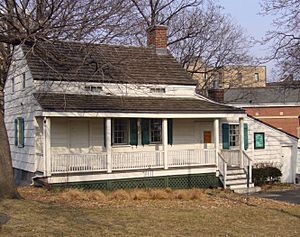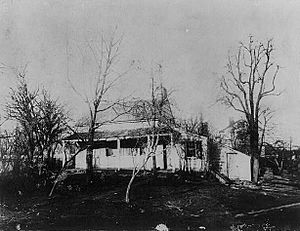Edgar Allan Poe Cottage facts for kids

Edgar Allan Poe Cottage, March 2007
|
|
| Location | 2640 Grand Concourse, Fordham, Bronx, NY, |
|---|---|
| Type | Historic house museum |
| Public transit access |
|
|
Poe Cottage
|
|
| Lua error in Module:Location_map at line 420: attempt to index field 'wikibase' (a nil value). | |
| Area | 3 acres (1.2 ha) |
| Built | 1812 |
| Architect | John Wheeler |
| NRHP reference No. | 80002588 |
| Significant dates | |
| Added to NRHP | August 19, 1980 |
The Edgar Allan Poe Cottage is a special historic house in the Bronx, New York. It was once the home of the famous American writer Edgar Allan Poe. The cottage is located on Kingsbridge Road and the Grand Concourse, inside the northern part of Poe Park.
This cottage is part of the Historic House Trust and is listed on the National Register of Historic Places. The Bronx County Historical Society has managed it since 1975. Experts believe the cottage was built in 1797.
Contents
History of the Poe Cottage
Poe Family Life in the Cottage
Edgar Allan Poe, his wife Virginia Clemm, and her mother Maria moved into this cottage around May 1846. Before this, they lived for a short time in Turtle Bay, Manhattan. At that time, Fordham, where the cottage was, was a quiet countryside area. It had only recently been connected to the city by train.
The cottage was small and simple. On the first floor, it had a sitting room and a kitchen. The second floor had a bedroom and Poe's study, but it was not heated. The family kept caged songbirds on the front porch. The home sat on about 2 acres of land. Poe paid a small rent for the cottage.
How the Poe Family Felt About Their Home
Even though the cottage was small, the family seemed to love it. A visitor once said, "The cottage is very humble... but there was an air of refinement about everything." A friend of Poe's later wrote that the cottage had a "charming dwelling." Poe himself wrote to a friend, "The place is a beautiful one." Maria, Poe's mother-in-law, later remembered, "It was the sweetest little cottage imaginable. Oh, how supremely happy we were in our dear cottage home!" Poe's last short story, "Landor's Cottage," was likely inspired by this very house.
Poe's Creative Works in the Cottage
While living in this home, Poe wrote some of his famous poems. These include "Annabel Lee" and "Ulalume". He often wrote with the family cat sitting on his shoulder. The church bells from what is now Fordham University also inspired his poem "The Bells".
The Poe family became good friends with their neighbors, including the Valentine family. Poe even helped with the baptism of one of the local boys. He also became friendly with the teachers at St. John's College, which is now Fordham University.
Virginia Poe's Illness and Passing
During their time in the cottage, Poe's wife, Virginia, was very sick with tuberculosis. A family friend, Mary Gove Nichols, noted that Virginia seemed to be fading away. Virginia passed away in the cottage's first-floor bedroom on January 30, 1847. She was buried a few days later.
Poe himself passed away a couple of years later, on October 7, 1849, in Baltimore. Maria, his mother-in-law, did not hear about his passing until after he was already buried. Soon after, she moved out of the cottage to live with another family.
Moving the Cottage to a New Home
After the Poe family left, the cottage's immediate use is not fully known. In 1874, an article described the cottage as being "dreadfully out of repair." In 1889, the cottage was sold at an auction. This was an early step in trying to save the historic building.
In 1895, the New York Shakespeare Society bought the cottage. They promised to keep it in the same condition as when Poe lived there. However, people soon worried about moving the cottage. An article in 1896 asked, "Shall We Save the Poe Cottage at Fordham?" It urged the New York State Legislature to help save the home. Important figures like Theodore Roosevelt supported this idea.
In 1905, the state government approved money to restore the cottage and create a park for it. Some people felt the money could be better spent elsewhere. Others worried that moving the cottage would make it less authentic. The decision to move it was made in 1910. On November 13, 1913, the Poe Cottage was officially opened in Poe Park. It was placed at the corner of Kingsbridge Road and the Grand Concourse. In 1922, the New York Historical Society did more work to restore the cottage to its original look.
Recent History of the Cottage
In 1962, Poe's Cottage was named a Bronx landmark. In 1966, the New York City Landmarks Preservation Commission recognized it as an official city landmark. In 1974, the cottage faced some damage from vandalism. This led to more discussions about how to protect and manage the cottage.
Over the next few years, vandalism continued but then decreased. This was partly because people started living in the cottage as caretakers. In the late 1990s, a student who studied languages lived in the basement and looked after the cottage.
In 2007, a plan for a new Visitors Center for the Cottage and Bronx Historical Society in Poe Park won an award. This visitor center, designed by Toshiko Mori, opened in 2008. It was one of the first projects completed under Mayor Michael Bloomberg's plan to improve city designs.
See also
- Edgar Allan Poe Museum in Richmond, Virginia
- Edgar Allan Poe House and Museum in Baltimore, Maryland
- Edgar Allan Poe National Historic Site in Philadelphia, Pennsylvania
- List of museums and cultural institutions in New York City
- List of New York City Designated Landmarks in the Bronx
- National Register of Historic Places listings in the Bronx




